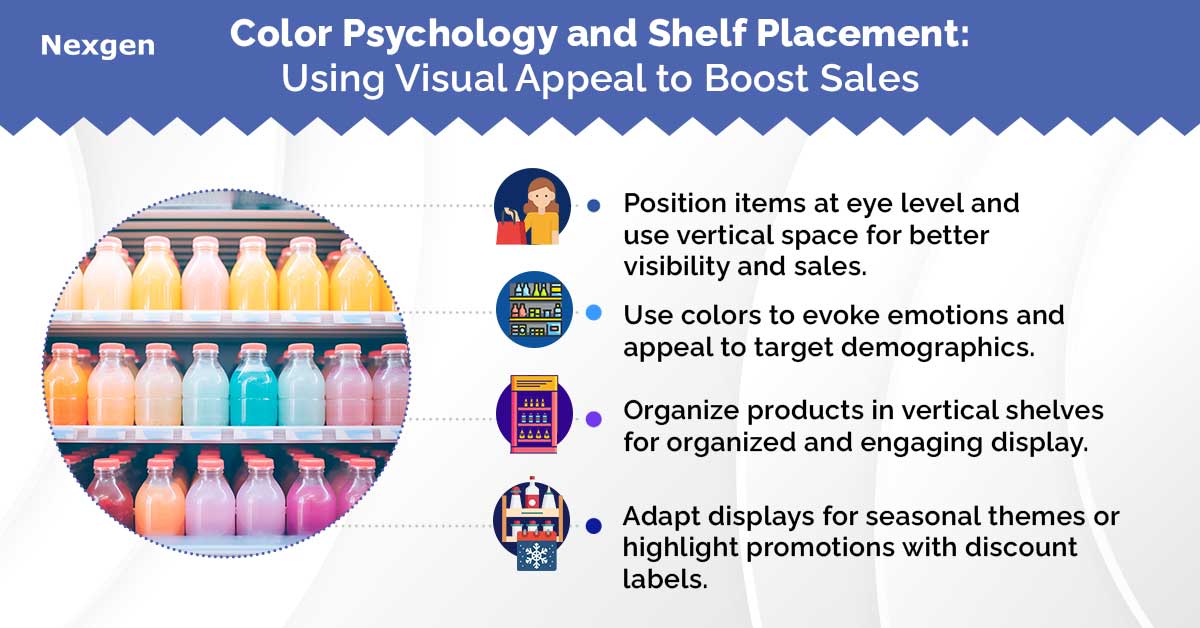In retail, where every detail matters, leveraging color psychology and strategic shelf placement through planograms can significantly impact sales. Utilizing data-driven insights from planograms, retailers can optimize shelf layouts, create compelling visual hierarchies, and adapt quickly to market trends, driving higher sales conversions and fostering a more satisfying shopping experience for customers. Here is a deep dive into how planogram elements work together to create a compelling retail environment:

Understanding Vertical Merchandising
It involves organizing products on shelves in vertical columns rather than horizontal rows. This technique leverages the natural scanning pattern of customers, who typically look from top to bottom when browsing shelves. By arranging products in vertical sections, retailers can create a more organized and visually appealing display that guides customer’s shopping.
The Importance of Color Psychology
- Creating emotional connections: Colors evoke emotions and influence perceptions. For instance, warm tones like red and orange can create a sense of urgency or excitement, making them ideal for promoting clearance items or limited time offers. On the other hand, cool colors such as blue and green convey calmness and trust, making them suitable for health and wellness products or eco-friendly items.
- Brand identity and recognition: Consistent use of brand colors helps in building recognition and reinforcing brand identity. When integrated into shelf displays, these colors can enhance brand recall and strengthen customer loyalty.
- Targeting specific demographics: Different demographics respond differently to colors. Understanding your target audience enables you to choose colors that resonate with their preferences and cultural associations, thereby increasing the appeal of your products.
Strategic Shelf Placement Ideas
- Eye-level visibility: Products placed at eye level using planograms are more likely to capture shoppers' attention first. This prime shelf space is ideal for highlighting best-selling items or new arrivals, maximizing their visibility and potential for sales.
- Complementary product pairing: Grouping complementary products together encourages cross-merchandising and enhances the shopping experience. For example, pairing pasta sauce with pasta or batteries with electronics not only increases convenience for shoppers but also boosts sales through suggestive selling techniques.
- Utilizing vertical space: Maximizing vertical space by using shelves of varying heights creates visual interest and allows for showcasing a wider range of products. This approach can facilitate easier navigation for shoppers, leading to a more pleasant shopping experience and drive sales.
Practical Applications and Examples
- Seasonal themes and holidays: Adapting shelf displays to reflect seasonal themes or upcoming holidays can capture the festive spirit and prompt impulse purchases. Using appropriate colors and decorations enhances the overall ambiance and encourages customers to explore seasonal offerings.
- Promotions and special offers: Highlighting promotions and special offers with bold colors or signage draws attention and increases urgency among shoppers. Placing these items strategically near high-traffic areas or checkout counters can further enhance their visibility and effectiveness.
- Testing and regular evaluation: Regularly evaluating the impact of shelf layouts through heat maps indicate where customers tend to look first when scanning shelves. Retailers can use this information to place popular or high-margin items at eye-level, ensuring they capture immediate attention and are more likely to be purchased. Visual analysis helps in identifying which products benefit most from prime shelf real estate, optimizing revenue opportunities.
Overview of Nexgen POG
Nexgen POG is a robust and user-friendly cloud-based visual merchandising tool. It is designed for quick and efficient planogramming with minimal effort. Planogram in retail can be designed by easily dragging and dropping the products. The multi-device compatibility feature of POG allows you to obtain, share and edit planogram on any device, including your phone. It helps in designing store-specific planograms for increased product visibility and sales.
Get Your Free Trial Now!